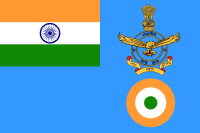John Miles Steel
Air Chief Marshal Sir John Miles Steel, GCB, KBE, CMG (11 September 1877 – 2 December 1965) was a senior Royal Air Force commander.
- For other persons named John Steel, see John Steel.
Sir John Miles Steel | |
|---|---|
| Born | 11 September 1877 |
| Died | 2 December 1965 (aged 88) |
| Allegiance | United Kingdom |
| Service/ | Royal Navy (c. 1897–18) Royal Air Force (1918–45) |
| Years of service | 1897–37 1939–45 |
| Rank | Air Chief Marshal |
| Commands held | Reserve Command (1939–40) Bomber Command (1936–37) Air Defence of Great Britain (1935–36) RAF India (1931–35) Wessex Bombing Area (1926–30) No. 8 Group (1918) No. 58 Wing (1918) RNAS Eastchurch (1917–18) |
| Battles/wars | Second Boer War First World War Second World War |
| Awards | Knight Grand Cross of the Order of the Bath Knight Commander of the Order of the British Empire Companion of the Order of St Michael and St George Mentioned in Despatches (2) Order of Saint Stanislaus, 2nd Class with Swords (Russia) |
Military career
Steel attended Britannia Naval College in 1892[1] and subsequently served in the Royal Navy.[2] He was promoted to sub-lieutenant in 1897 and served in the Second Boer War as a member of the Naval Brigade.[2] He was promoted to lieutenant in 1900, and was posted temporary in July 1902 to HMS St George, serving in the Channel Squadron.[3] A permanent posting followed in September that year, when he was posted to HMS Royal Sovereign,[4] coast guard ship at Portsmouth. Promotion to commander followed in 1912, and to captain in 1916.[2]
In 1917 Steel was transferred from fleet duties to the Royal Naval Air Service and was appointed Officer Commanding RNAS Eastchurch.[2] In early 1918 Steel was appointed Officer Commanding No. 58 Wing which was based at Eastchurch[2] and in March, at the age of 40, Steel learned to fly.[2] Meanwhile, he became General Officer Commanding No. 8 Group.[2] On 1 April 1918 the Royal Naval Air Service merged with the Royal Flying Corps to form the Royal Air Force.[2] Steel, like other RNAS personnel transferred to the RAF and was promoted to the temporary rank of brigadier general.[2] Promoted to group captain and then air commodore in 1919 he was appointed Deputy Chief of the Air Staff and Director of Operations and Intelligence and, following his promotion to air vice marshal in 1925, he was made Air Officer Commanding the Wessex Bombing Area and then Air Officer Commanding RAF India.[2] He was promoted to air marshal in 1932 and appointed Air Officer Commanding-in-Chief, Air Defence of Great Britain in August 1935.[2] When Bomber Command was created from the Air Defence of Great Britain command in July 1936, Steel became its first Air Officer Commanding-in-Chief in the rank of air chief marshal.[2]
Second World War
In August 1939 Steel came back from retirement to serve as Air Officer Commanding Reserve Command.[2] In April 1940 he was succeeded as AOC by William Welsh and Steel returned to retirement.[2] The following year in April once again returned to active service, this time as the Controller-General of Economy at the Air Ministry.[2] He retired for the last time on 26 September 1945.[2]
References
- Liddell Hart Centre for Military Archives
- Air of Authority – A History of RAF Organisation – Air Chief Marshal Sir John Steel
- "Naval & Military intelligence". The Times (36808). London. 1 July 1902. p. 7.
- "Naval & Military intelligence". The Times (36863). London. 3 September 1902. p. 4.
| Military offices | ||
|---|---|---|
| Preceded by Robert Groves |
Deputy Chief of the Air Staff and Director of Operations and Intelligence 8 September 1919 – 12 April 1926 |
Succeeded by Cyril Newall |
| Preceded by Geoffrey Salmond |
Air Officer Commanding RAF India 1931–1935 |
Succeeded by Sir Edgar Ludlow-Hewitt |
| Preceded by Sir Robert Brooke-Popham |
Air Officer Commanding-in-Chief Air Defence of Great Britain 1935–1936 |
Succeeded by None |
| Preceded by New Creation |
Air Officer Commanding-in-Chief Bomber Command 1936–1937 |
Succeeded by Sir Edgar Ludlow-Hewitt |
| Preceded by Sir Christopher Courtney |
Air Officer Commanding-in-Chief Reserve Command 1939–1940 |
Succeeded by Sir William Welsh |
